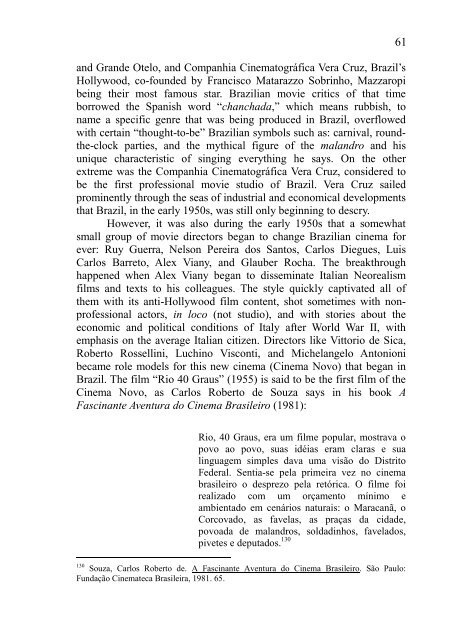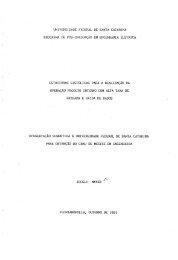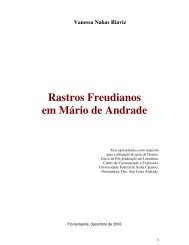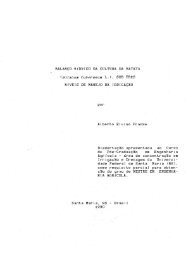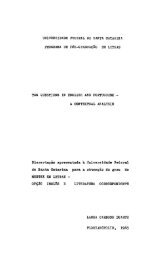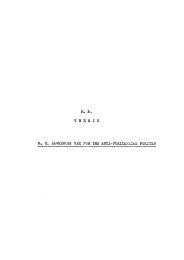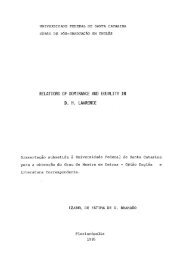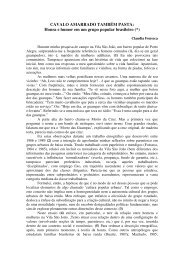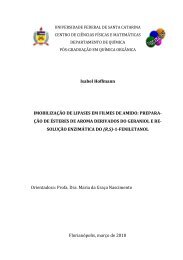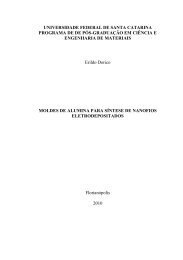Tropical ginsberg
Tropical ginsberg
Tropical ginsberg
Create successful ePaper yourself
Turn your PDF publications into a flip-book with our unique Google optimized e-Paper software.
and Grande Otelo, and Companhia Cinematográfica Vera Cruz, Brazil’s<br />
Hollywood, co-founded by Francisco Matarazzo Sobrinho, Mazzaropi<br />
being their most famous star. Brazilian movie critics of that time<br />
borrowed the Spanish word “chanchada,” which means rubbish, to<br />
name a specific genre that was being produced in Brazil, overflowed<br />
with certain “thought-to-be” Brazilian symbols such as: carnival, roundthe-clock<br />
parties, and the mythical figure of the malandro and his<br />
unique characteristic of singing everything he says. On the other<br />
extreme was the Companhia Cinematográfica Vera Cruz, considered to<br />
be the first professional movie studio of Brazil. Vera Cruz sailed<br />
prominently through the seas of industrial and economical developments<br />
that Brazil, in the early 1950s, was still only beginning to descry.<br />
However, it was also during the early 1950s that a somewhat<br />
small group of movie directors began to change Brazilian cinema for<br />
ever: Ruy Guerra, Nelson Pereira dos Santos, Carlos Diegues, Luis<br />
Carlos Barreto, Alex Viany, and Glauber Rocha. The breakthrough<br />
happened when Alex Viany began to disseminate Italian Neorealism<br />
films and texts to his colleagues. The style quickly captivated all of<br />
them with its anti-Hollywood film content, shot sometimes with nonprofessional<br />
actors, in loco (not studio), and with stories about the<br />
economic and political conditions of Italy after World War II, with<br />
emphasis on the average Italian citizen. Directors like Vittorio de Sica,<br />
Roberto Rossellini, Luchino Visconti, and Michelangelo Antonioni<br />
became role models for this new cinema (Cinema Novo) that began in<br />
Brazil. The film “Rio 40 Graus” (1955) is said to be the first film of the<br />
Cinema Novo, as Carlos Roberto de Souza says in his book A<br />
Fascinante Aventura do Cinema Brasileiro (1981):<br />
61<br />
Rio, 40 Graus, era um filme popular, mostrava o<br />
povo ao povo, suas idéias eram claras e sua<br />
linguagem simples dava uma visão do Distrito<br />
Federal. Sentia-se pela primeira vez no cinema<br />
brasileiro o desprezo pela retórica. O filme foi<br />
realizado com um orçamento mínimo e<br />
ambientado em cenários naturais: o Maracanã, o<br />
Corcovado, as favelas, as praças da cidade,<br />
povoada de malandros, soldadinhos, favelados,<br />
pivetes e deputados. 130<br />
130 Souza, Carlos Roberto de. A Fascinante Aventura do Cinema Brasileiro. São Paulo:<br />
Fundação Cinemateca Brasileira, 1981. 65.


